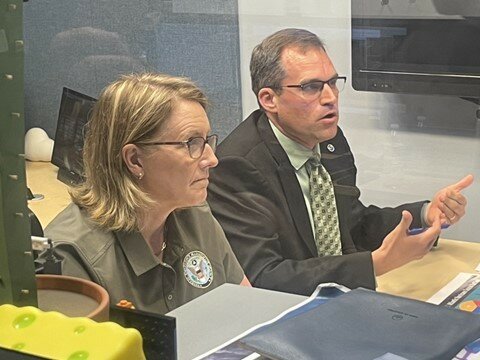FEMA administrator visits National Hurricane Center
Urges residents to prepare now ahead of hurricane season
FEMA Administrator Deanne Criswell visited the National Hurricane Center in Miami on Wednesday to meet with meteorologists ahead of the official start of the Atlantic hurricane season, which begins today (Thursday, June 1).
“Hurricanes today are developing faster and intensifying more rapidly than they have in the past,” said Criswell. “We have also seen major impacts from hurricanes in communities far from the coast. That’s why people should know their risk, determine how they will get information and make a plan today. The time to prepare is now.”
Criswell and National Hurricane Center Director Mike Brennan briefed media on preparedness actions to take before a storm threatens.
Last week, the National Oceanic and Atmospheric Administration released the 2023 Hurricane Season outlook, which forecasts up to 17 named storms, including up to nine hurricanes. One to four of these potential hurricanes are forecast to be “major hurricanes,” with winds of 111 mph or higher.
No matter what the hurricane season outlook says, it only takes one storm to bring widespread devastation.
Hurricanes affect more than coastal communities. These powerful storms can bring wind and flooding to areas far inland, so it’s important to know the risks where you live: rain, wind and flooding could happen far from the coast.
Start Preparing Now
The best way to help the community recover from a disaster is by taking steps now to prepare. Consider these actions to make sure you and your family are protected during the 2023 hurricane season:
- Have a way to receive emergency alerts from emergency officials.
- Download the free FEMA App to get weather alerts and updates for up to five different locations anywhere in the United States.
- Visit Ready.gov/plan and use the new "Make a Plan" fillable form to walk through all the steps to begin your plan and then easily save an electronic copy or share with other family members.
- FEMA’s Text-to-Shelter feature can also let you know how to find shelter during an evacuation this year. When there’s an evacuation order issued, you can text “shelter” and your ZIP code to 43362 for a list of nearby shelter locations.
- Many shelters do not take household pets, so remember to create a plan and have supplies available for your pets.
- Storms may leave your area without power and water for days or weeks. Stock your pantry with non-perishable food, water and medicine. Learn how to build a disaster supply kit that meets the specific needs of every member of your family.
- Remember, standard homeowner’s and renter’s insurance doesn’t cover flooding. You can get flood coverage from your insurance company or the National Flood Insurance Program at floodsmart.gov. Act now, as flood insurance requires a 30-day waiting period.
Disasters are costly, but preparing for them doesn’t have to be. In fact, taking time to prepare now can help save thousands of dollars and give you peace of mind when the next disaster or emergency occurs. FEMA’s Ready Campaign recently published a low and no-cost preparedness webpage with tips to help preparedness for a variety of disasters and emergencies, including:
- Building your emergency supply kit over time, starting with items you may already have in your home — like a flashlight, extra batteries, copies of important documents, water and non-perishable food.
- Talking with family or members of your household about where you will go if told to evacuate.
- Storing important documents and items like passports, birth certificates, maps and electronics in a flood-safe place, like a high shelf or upper floor in resealable water-tight plastic bags to help waterproof them.







